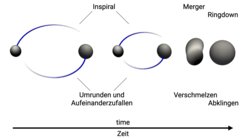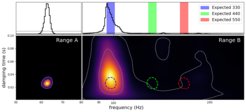For whom the black hole rings
Observation of multiple ringdown modes in a black hole merger
An international team led by researchers from the Max Planck Institute for Gravitational Physics (Albert Einstein Institute, AEI) in Hannover has found strong observational evidence for multiple gravitational-wave frequencies in a binary black hole ringdown. The team discovered that the intermediate-mass black hole formed in the GW190521 event vibrated briefly at at least two frequencies after the merger. This ringdown is a fundamental prediction from general relativity. Its observation allows tests of the theory and of the black hole no-hair theorem. The scientists found no violations of the theorem or deviations from general relativity. It was widely assumed that this observation of multiple tones would be impossible before the next generation of gravitational-wave detectors. Nevertheless, the unexpected massive merger remnant of GW190521 together with exquisite data analysis methods make the detection possible. The results were published in Physical Review Letters.

When two black holes collide, gravitational waves are emitted in three phases: when they inspiral, when they merge, and when the newly formed initially lopsided black hole settles into its final stage. The last phase, called “ringdown”, is a fraction-of-a-second period of black hole vibrations that – according to Einstein’s theory of general relativity – encode information about the mass and the spin of the final black hole.
A black hole rings like a bell
“The black hole is similar to a bell that rings, producing a spectrum of multiple fading tones, that encode information about the bell,” explains Collin Capano, corresponding author of the study published in Physical Review Letters and formerly a researcher in the Observational Relativity and Cosmology department at the Max Planck Institute for Gravitational Physics (Albert Einstein Institute, AEI) in Hannover.
An international team led by researchers from the AEI Hannover analyzed public LIGO and Virgo data from the GW190521 event, which is one of the most massive binary black hole mergers observed to date. They discovered a chord of two damped tones (also called “quasi-normal modes”) present in the gravitational waves emitted during the ringdown phase of the event.
Ringdown at two frequencies

“Achieving this multimode observation – in other words, the detection of two distinct vibration frequencies of a deformed black hole – has been a welcome surprise. It was widely assumed this would not be possible before the next generation of gravitational-wave detectors,” says Capano.
The researchers performed an agnostic search for the frequencies present in GW190521’s ringdown. They searched for individual fading tones and did not assume any relation between the modes’ frequencies and their damping times. They identified two modes: A fundamental mode at a frequency of 63 Hertz and a second one at 98 Hertz with damping times of 26 milliseconds and 30 milliseconds, respectively. These values are consistent with those from numerical relativity simulations of black hole collisions.
No hair on GW190521
The no-hair theorem states that in general relativity black holes are completely characterized by three externally accessible quantities: their mass, spin, and electric charge, although charge is negligible for astrophysical black holes. No further information, or additional “hair” is required to describe them. The frequencies of the ringdown modes and their damping times of the black hole formed in GW190521 must therefore be determined by mass and spin only.
Numerical simulation of a heavy black-hole merger (GW190521)
“We tested the black hole no-hair theorem by comparing the frequencies and the damping times of the two modes we found in the GW190521 ringdown,” says Julian Westerweck, co-author of the publication and a former PhD student in the Observational Relativity and Cosmology department at AEI Hannover. “GW190521 passed the test and we found no signs of any black hole physics beyond Einstein’s general theory of relativity. It is quite remarkable that a theory that is over one hundred years old now continues to work so well.”
The research team assumed that the frequency and decay time of the fundamental vibration mode of the black hole depend on its mass and spin as predicted by Einstein’s theory. They allowed the frequency and decay time of the second mode to deviate from the values expected in general relativity and checked how well such deviations fit the observations. Their analysis found no such deviations and showed that GW190521 is consistent with Einstein’s theory.
The results also exclude two alternative proposals about the somewhat mysterious nature of GW190521. Both a head-on collision of exotic stars and the collapse of a massive star to a black hole with a high-mass disk are not compatible with the observed multimodal ringdown.
“More than 20 years ago, we had proposed such observations as a means of testing the nature of black holes” says Badri Krishnan, co-author, long-term visitor and former staff member at AEI Hannover, currently professor at Radboud University. “At the time we did not believe that the LIGO and Virgo detectors would be able to observe multiple ringdown modes. Therefore these results are particularly gratifying for me.”














